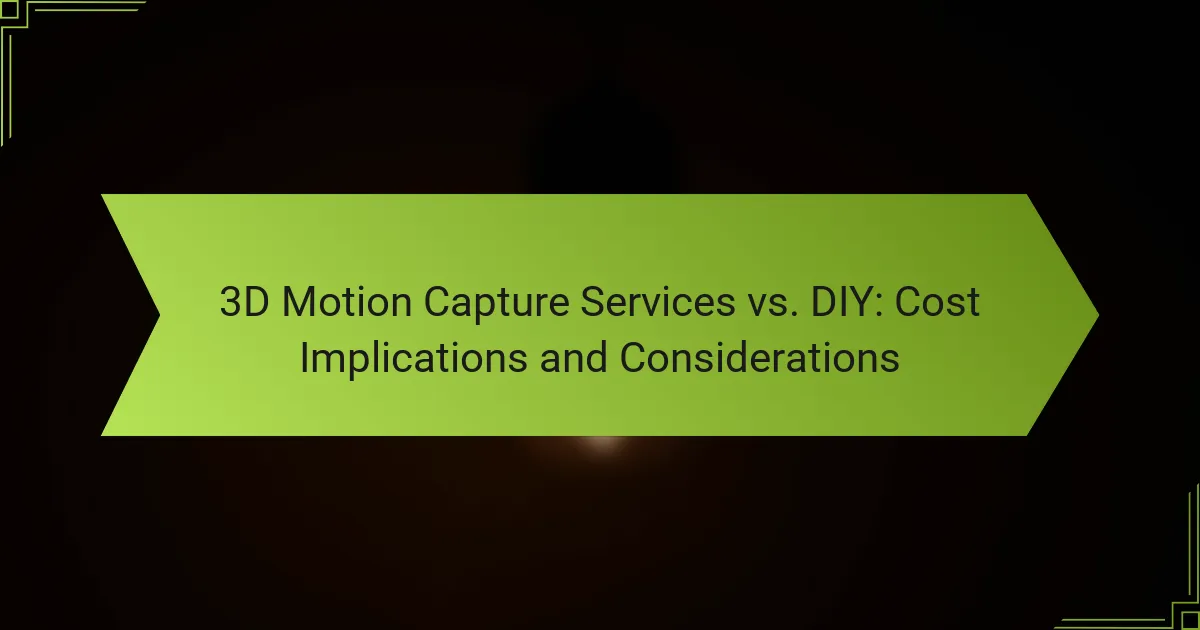When considering 3D motion capture, businesses face a choice between professional services and a DIY approach, each with distinct cost implications. While hiring experts can ensure high-quality results and technical support, it often comes at a higher price. Conversely, DIY motion capture may seem more budget-friendly initially, but it entails significant upfront investments and ongoing maintenance costs. Understanding these financial factors is essential for making an informed decision that aligns with project goals and budget constraints.

What are the cost implications of 3D motion capture services in Los Angeles?
The cost of 3D motion capture services in Los Angeles can vary significantly based on the provider, technology used, and project requirements. Generally, businesses should expect to invest several thousand dollars for professional services, which can offer high-quality results and technical support.
Average pricing for professional services
In Los Angeles, the average cost for professional 3D motion capture services typically ranges from $2,000 to $10,000 per day, depending on the complexity of the project and the level of expertise required. For smaller projects or independent filmmakers, some companies may offer packages starting around $1,000 for a few hours of capture.
Additionally, some studios may charge extra for post-production services, which can add another few hundred to several thousand dollars to the total cost. It’s advisable to request detailed quotes that outline all potential expenses.
Factors influencing service costs
Several factors can influence the costs of 3D motion capture services, including the technology used, the experience of the team, and the duration of the project. High-end systems with advanced capabilities, such as real-time capture or extensive motion libraries, tend to be more expensive.
The complexity of the motion being captured also plays a role; intricate movements or large ensembles may require more sophisticated setups and additional personnel, increasing costs. Furthermore, location and studio reputation can affect pricing, with well-known studios often commanding higher fees.

How does DIY motion capture compare in terms of expenses?
DIY motion capture can be significantly less expensive than hiring professional services, but it requires a considerable initial investment and ongoing costs for maintenance. Understanding these financial implications is crucial for anyone considering a DIY approach.
Initial investment for DIY setup
The initial investment for a DIY motion capture setup can vary widely, typically ranging from a few hundred to several thousand dollars. Key components include cameras, sensors, software, and possibly a dedicated computer. For example, a basic setup might cost around $1,000, while a more advanced system could exceed $5,000.
When planning your budget, consider the quality and capabilities of the equipment. Cheaper options may suffice for simple projects, but higher-quality gear will yield better results, especially for professional applications.
Ongoing costs of maintenance and upgrades
Ongoing costs for a DIY motion capture system include software updates, hardware maintenance, and potential upgrades. Software licenses can range from free to several hundred dollars annually, depending on the features required. Additionally, hardware may need repairs or replacements over time, which can add to your expenses.
Regularly assessing your system’s performance can help you determine when upgrades are necessary. Investing in quality components initially may reduce long-term costs, as they often require less frequent replacement or repair.

What are the benefits of using professional motion capture services?
Using professional motion capture services offers significant advantages, including access to high-end technology and expertise that can enhance the quality of your projects. These services can save time and resources while delivering superior results compared to DIY methods.
Access to advanced technology
Professional motion capture services utilize state-of-the-art equipment that may not be feasible for individual users to acquire. This includes high-resolution cameras, sophisticated software, and specialized rigs that capture intricate movements with precision. By leveraging this technology, you can achieve a level of detail and accuracy that DIY setups often lack.
Additionally, these services often provide access to various capture environments, such as controlled studios that minimize external interference. This ensures that the data collected is clean and reliable, which is crucial for high-quality outputs in animation or game development.
Expertise and quality assurance
Professionals in motion capture bring a wealth of experience and knowledge to the table, ensuring that the capture process runs smoothly and efficiently. Their expertise allows them to troubleshoot issues that may arise during sessions, which can save time and prevent costly mistakes. They understand the nuances of motion capture, from actor positioning to data processing.
Moreover, professional services typically include quality assurance checks, ensuring that the final output meets industry standards. This level of scrutiny can be invaluable, especially for projects that demand high fidelity, such as feature films or AAA video games, where even minor errors can impact the overall quality.

What are the drawbacks of DIY motion capture?
DIY motion capture can lead to several significant drawbacks, primarily related to quality and efficiency. While it may seem cost-effective, the potential issues often outweigh the benefits, especially for professional applications.
Potential for lower quality results
One major drawback of DIY motion capture is the potential for lower quality results compared to professional services. Without access to high-end equipment and expertise, the accuracy and fidelity of the captured motion may suffer, leading to unrealistic animations or misrepresentations of movement.
For instance, consumer-grade cameras and sensors may struggle with tracking precision, resulting in data that requires extensive post-processing. This can be particularly problematic in industries like gaming or film, where high standards for visual quality are essential.
Time investment and learning curve
Another consideration is the time investment and learning curve associated with DIY motion capture. Setting up a motion capture system, calibrating equipment, and learning software can take considerable time, often stretching into weeks or months for beginners.
Moreover, troubleshooting technical issues can be frustrating and time-consuming. For those on tight deadlines, this can lead to delays that may negate any initial cost savings. It’s crucial to weigh the time spent against the benefits of hiring professionals who can deliver results more efficiently.

What criteria should be considered when choosing between services?
When deciding between 3D motion capture services and a DIY approach, consider project requirements, budget constraints, and available resources. Each option has distinct advantages and challenges that can significantly impact your project’s success.
Project requirements and complexity
The complexity of your project plays a crucial role in determining whether to use professional services or to attempt a DIY solution. For intricate projects requiring high precision, such as feature films or detailed animations, professional services are often more reliable due to their advanced technology and expertise.
Conversely, simpler projects, like basic animations or prototypes, may be feasible with DIY methods. Assess the specific needs of your project, including the level of detail and the intended use of the captured motion data, to make an informed choice.
Budget constraints and resource availability
Your budget is a significant factor when choosing between motion capture services and a DIY approach. Professional services can range from hundreds to thousands of USD, depending on the project’s scale and complexity. If your budget is limited, consider whether a DIY setup, which may require an initial investment in equipment and software, is more feasible.
Additionally, evaluate the resources you have at hand. If you possess the technical skills and equipment for DIY motion capture, it may be a cost-effective option. However, if you lack expertise or access to necessary tools, hiring a professional service could save time and enhance the quality of your project.

What are the emerging trends in motion capture technology?
Emerging trends in motion capture technology focus on enhancing accuracy, efficiency, and integration with other digital platforms. Innovations such as real-time capture and virtual reality integration are reshaping how motion capture is utilized across various industries.
Advancements in real-time capture
Real-time motion capture technology allows for immediate feedback during the recording process, significantly speeding up production timelines. This advancement is particularly beneficial in fields like gaming and film, where quick iterations are essential.
Modern systems can achieve low latency, often in the range of single-digit milliseconds, which enhances the user experience and allows for seamless integration into live performances or interactive applications. Companies should consider investing in high-quality sensors and software to maximize the benefits of real-time capture.
Integration with virtual reality platforms
The integration of motion capture with virtual reality (VR) platforms is transforming how users interact with digital environments. This synergy enables more immersive experiences, as users’ movements can be accurately reflected in virtual spaces.
When selecting motion capture solutions for VR, it is crucial to ensure compatibility with existing VR hardware and software. Companies should also evaluate the cost of integration, which can vary widely based on the complexity of the setup and the technology used. Investing in systems that support both motion capture and VR can streamline workflows and enhance overall production quality.
